 Fenix Tours
Fenix Tours

Prices and booking => please, scroll down
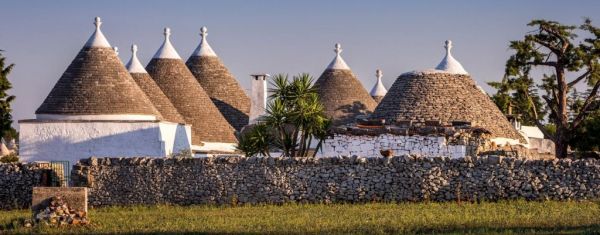

Trulli surrounded by vineyards and olive groves as far as the eye can see, this is the most authentic face of the Valle d’Itria. The landscape fills the gaze with timeless magic, in the heart of charming villages such as Alberobello, Locorotondo, Martina Franca, Ostuni and Cisternino.
The Valle d'Itria lies in the southern part of the Murgia plateau and in the strict sense is the karstic depression that extends between the towns of Locorotondo, Cisternino and Martina Franca. The main peculiarity of the valley are the trulli, typical and exclusive cone-shaped stone dwellings, the farmhouses and the rural landscape in general characterized by the high use of local stone used to build dry stone walls and bright red soil, typical of southern Puglia. Also known as "Valle dei Trulli", it extends between the provinces of Bari, Taranto and Brindisi and, in addition to the municipalities of Locorotondo, Martina Franca and Cisternino, small portions of the Valle d'Itria also fall within the municipalities of Alberobello, Ostuni, Fasano and Ceglie Messapica.

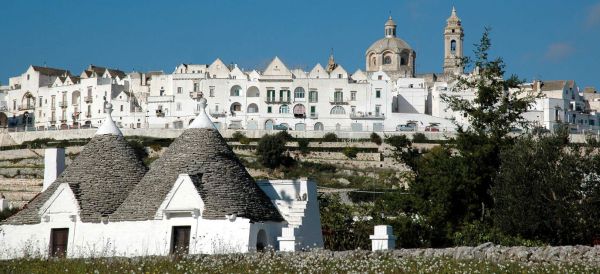
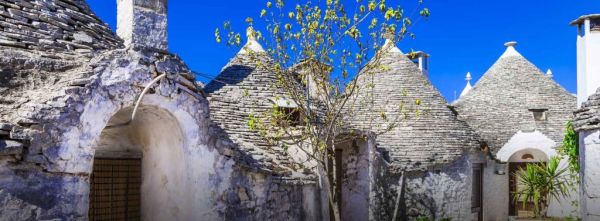
By clicking on the images you open the destination sites
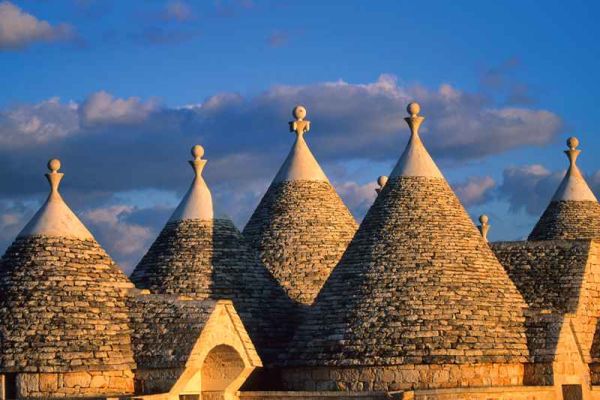
The impressive trulli of Alberobello were recognized as a World Heritage Site in 1996 and awarded with the Orange Flag by the Italian Touring Club by virtue of its excellent accommodation and architectural harmony. Winding alleyways and characteristic small squares intertwine in the Rione Monti, where the "Siamese trulli" are distinguished, from the original two-cone roof, the Church of Sant’Antonio and the Trullo Sovrano. Don't miss the Museo del Territorio, housed in a complex of communicating trulli, and the Casa d’Amore, today a valuable tourist information point, the first building in the entire town built with lime and mortar. Less frequented than the Monti district but no less interesting is the historic district Aia Piccola
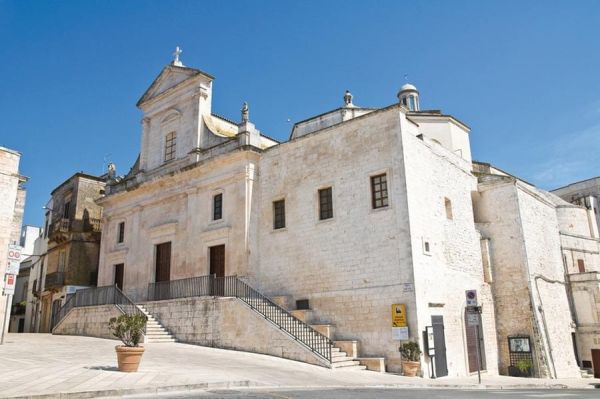
Located on the last edge of the south-eastern Apulian Murgia (394 m above sea level), it looks out on the Valle d’Itria studded with trulli. The name derives from "Cis-Sturninum", on this side of Sturni, an ancient Japige center near Ostuni that was named from Sturno, companion of the Homeric hero Diomede, escaped from the Trojan War. The first historical information (1107) on Cisternino comes from the donation of the Countess Sichelgaita, widow of Count Goffridus, who «donates to the Church and the monastery of S. Maria Antica in Brindisi, for the soul of her husband and son, as well as for his health and that of his other son Tanchredus », the villages of Tuturano and Valerano and other properties, including the «lama of Cisternino». The news, in an ancient document, of the presence of Cisternino in the medieval age, even if here we talk only of “lama” (creek) but the fact that it had a name, suggests that there was a human settlement or, more likely, a farmhouse.
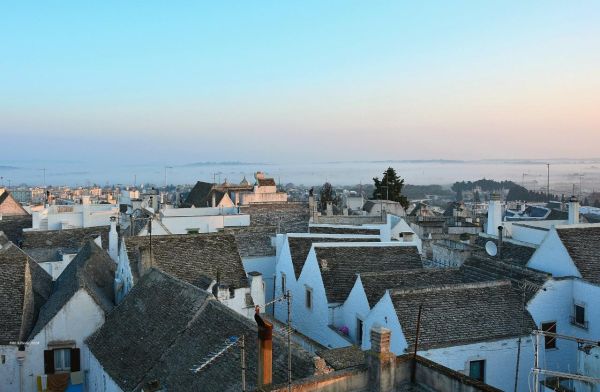
The beauty of the historic center of Locorotondo is represented by its labyrinth of white alleys, with low white washed houses on a hilltop overlooking the Valle d’Itria that end with unusual sloping roofs locally called "Cummerse". Locorotondo looks like a quiet and orderly town, in which it is pleasant to walk among the concentric streets of the historic center with the typical houses with sharp roofs and flowered balconies.
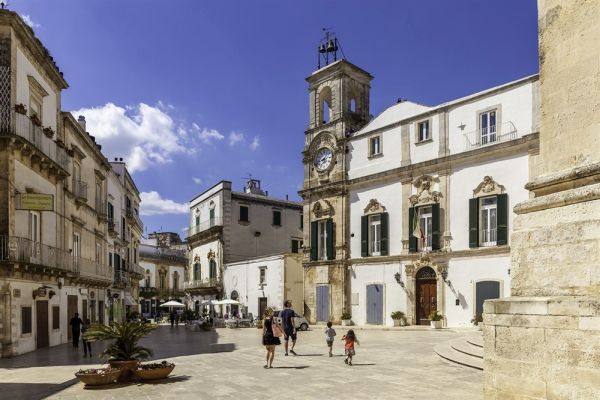
The urban center of Martina Franca stands in a dominant position over the valley, at 431 meters above sea level, from which you can admire the red earth of the Murgia dei Trulli, dotted with tens of thousands of trulli, from sumptuous farmhouses of ancient agro vocation silvo-pastoral and by the sinuous and orderly lattice of dry stone walls.
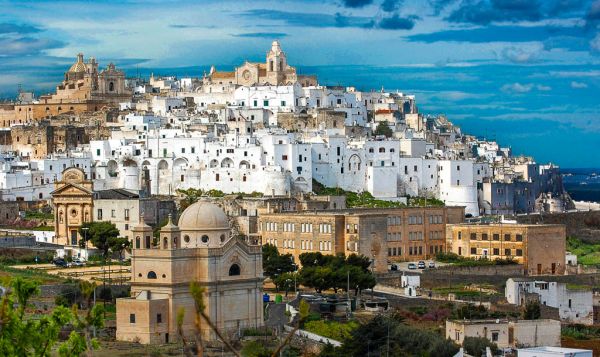
Ostuni, the White City, is picturesque and waiting to be discovered. Popular tourist destination Ostuni boasts a wonderful medieval village, full of narrow streets and dwellings whitewashed with lime in a maze that resembles an Arab casbah. A walk in the old city, called the "land" to distinguish it from the more recent "marina", offers picturesque views through alleys, steep stairways, courtyards and small squares overlooked by white houses embellished with geraniums, craft shops, typical restaurants and small shops.

Please do not forget to read the Terms & Conditions before booking. The reservation is valid after the payment of the advance or the full amount.
![]() For the same tour there are two prices based on the number of people. For groups of more than 8 people, please contact us.
For the same tour there are two prices based on the number of people. For groups of more than 8 people, please contact us.
 After deciding which excursion you want to do, click on the booking button that will open a partially pre-filled e-mail. You must indicate the tour, the date, the number of participants and your special requests. Probably it will take more than one e-mail to define the excursion but as soon as you receive our confirmation email, you can make the payment (in advance or in full).
After deciding which excursion you want to do, click on the booking button that will open a partially pre-filled e-mail. You must indicate the tour, the date, the number of participants and your special requests. Probably it will take more than one e-mail to define the excursion but as soon as you receive our confirmation email, you can make the payment (in advance or in full).

To make payment after clicking down payment or full payment button, a new window will open with several button

The upper buttons let you choose whether to pay with your Paypal account (if you have one), by credit card or any other online payment method existing in your country that is affiliated with Paypal. This alternative changes depending on the country.



If your currency is not the euro (€), it is advisable to pay via the Wise or XE platforms. Paypal applies commercial exchange rates (those of the bureaus of exchange for example) very unfavorable, while Wise and XE apply the official rates with very low fees. Simply open a Wise or XE account and make the payment via the mobile app or PC by making the transfer to the bank account of Fenix Tours. The bank details will be communicated to you in the confirmation e-mail

The balance can be paid either with Paypal, Wise and XE or at the latest, at the start of the tour by credit card or cash (euro).

The traditional destination of the Itria Valley is Alberobello, where most of the trulli are concentrated while scattered throughout the countryside of central Puglia. A characteristic of the Itria Valley is however the great concentration of this original housing structure and the wide spread of rural houses therefore a very important percentage of the local population does not live in urban centers but prefers the countryside to the town. Despite the relative proximity between them, the various urban centers of the Itria Valley have peculiarities that distinguish one another in an original way: Martina Franca, for the initiative of its inhabitants, shows the different architectural styles that have followed each other in the centuries after its foundation; Ostuni, called "white city" is strictly colored white; Cisternino is a real balcony over the Itria Valley; Locorotondo has an architecture of the houses of the old town far from the typical shape of the trulli. Despite the evident differences between the various centers of the Itria Valley, in the countryside the trulli are the dominant and common element. Each center then makes a little history to itself and shows its originality. In the visit of a day, evidently the visit is limited to two, maybe three of the centers of the Itria Valley but it remains a very suggestive visit and full of charm.

| 1-3 people | 4-7 people | ||||
| Full Price | Down Payment | Balance | Full Price | Down Payment | Balance |
| 700 € | 210 € | 490 € | 980 € | 294 € | 686 € |

The traditional destination of the Itria Valley is Alberobello, where most of the trulli are concentrated while scattered throughout the countryside of central Puglia. A characteristic of the Itria Valley is however the great concentration of this original housing structure and the wide spread of rural houses therefore a very important percentage of the local population does not live in urban centers but prefers the countryside to the town. Despite the relative proximity between them, the various urban centers of the Itria Valley have peculiarities that distinguish one another in an original way: Martina Franca, for the initiative of its inhabitants, shows the different architectural styles that have followed each other in the centuries after its foundation; Ostuni, called "white city" is strictly colored white; Cisternino is a real balcony over the Itria Valley; Locorotondo has an architecture of the houses of the old town far from the typical shape of the trulli. Despite the evident differences between the various centers of the Itria Valley, in the countryside the trulli are the dominant and common element. Each center then makes a little history to itself and shows its originality.
The two-day visit, therefore, allows you to visit the 5 historic centers of the Itria Valley making it very impressive and full of charm

| 1-3 people | 4-7 people | ||||
| Full Price | Down Payment | Balance | Full Price | Down Payment | Balance |
| 1120 € | 336 € | 784 € | 1568 € | 470 € | 1098 € |